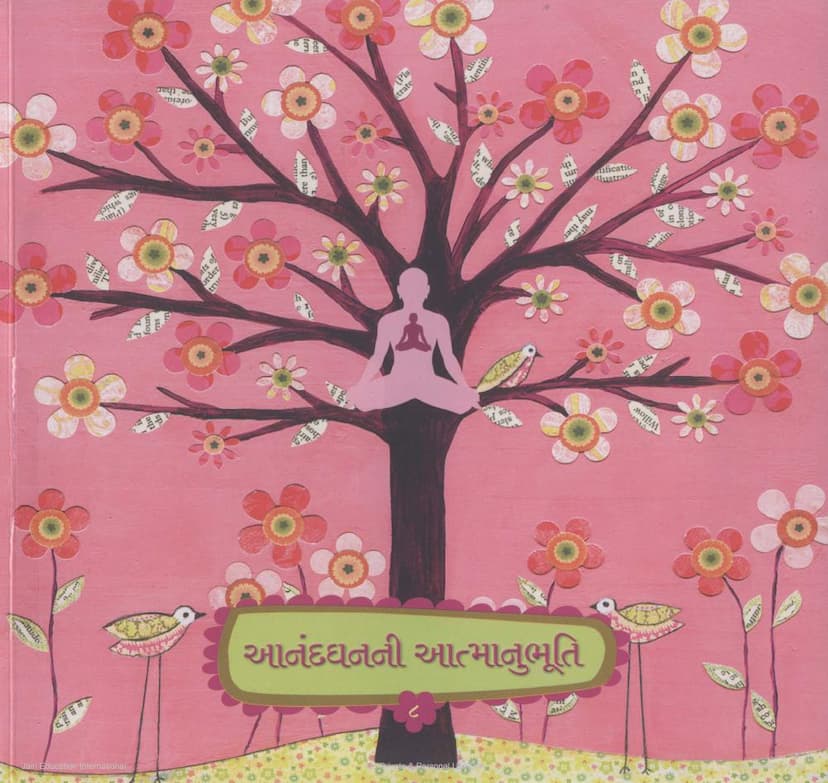Anandghan Ni Atmanubhuti 08
Added to library: September 1, 2025

Summary
Here's a comprehensive summary of the provided Jain text, "Anandghan ni Atmanubhuti 08":
This book, "Anandghan ni Atmanubhuti 08," is a commentary and exposition by Acharya Shri Vijay Kalyanbodhisurishwarji on an eighth spiritual song (pad) by the great ascetic yogi, Shri Anandghanji Maharaj. The publication is from the Jinshasan Aradhana Trust.
The core theme of the book is Atmanubhuti (Self-Realization), presented as an invaluable aid for ascending to the state of detachment (Vairagya) and equanimity (Samata), and for experiencing the true nature of the soul (Siddha Swaroop). It is offered as a fresh perspective for those on the path of Atmanubhuti.
The commentary delves into the understanding of the soul's nature through a profound analogy presented in Anandghanji's pad. The central verses discussed are:
- "Aatam anubhav phool ki, navli kou reet; Naak na pakre vaasana, kaan gahe paritit." This opening verse, translated as "The experience of the soul is like a flower, with a new kind of method; the nose cannot grasp its fragrance, but the ears perceive its essence," sets the stage for the unique nature of spiritual realization.
The book uses vivid analogies to illustrate key spiritual concepts:
-
The Frog in the Well: The initial pages highlight the limited perspective of the world that many experience, akin to a frog in a well who believes the well is the entire universe. This represents the delusion that worldly pleasures are the only forms of happiness. Anandghanji Maharaj is presented as the guide who helps one break free from this limitation and explore the "sky of realization."
-
The Flower Analogy (Nose vs. Ears): This is a central theme.
- Physical Flowers: Typically perceived through the nose (smell), with the ears unable to directly apprehend their fragrance.
- The Soul's Experience (Atmanubhuti): This is described as a unique flower whose fragrance cannot be caught by the physical nose. Instead, it is perceived by the "ears" of inner wisdom or intuition (Prajna). The book clarifies that the "ear" here refers not to the external sense organ but to the inner faculty of wisdom. The experience of the soul is indriya-atit (beyond the senses) and therefore free from attachment and aversion (Raga-Dvesha).
- This analogy also contrasts Raga-Dasha (state of attachment), Vairagya-Dasha (state of aversion), and Vitaraag-Dasha (state of complete non-attachment and equanimity).
- Being attracted to the fragrance of flowers is Raga.
- Considering the fragrance as undesirable is Vairagya.
- Maintaining equanimity towards both fragrance and foul smells, and accepting supreme indifference towards all associations, is Vitaraag-Dasha.
-
Mata (Attachment/Possessiveness) as the Hindrance: A significant portion of the commentary focuses on "Mata" as the primary obstacle to Atmanubhuti.
- The Analogy of Milking a Goat's Udder: The book repeatedly uses the analogy of "Mamata sang so paay ajaagal-than ten dudh duhaave" (One who keeps company with attachment, milks the teat on a goat's neck). This means trying to extract happiness from worldly possessions, body, family, or wealth is futile, as these are like a goat's barren teats, offering no real satisfaction. They are transient and ultimately lead to suffering.
- Examples of Mata: The book illustrates how Mata manifests in attachment to:
- The Body: Described as impure, prone to disease and decay, it is ultimately a vessel of suffering.
- Family: The relationships are transient, and the idea of "mine" causes pain.
- Wealth: Attachment to wealth leads to being reborn as plants or animals that guard their hidden treasures, and ultimately to suffering.
- The verses emphasize that "Mamata paramam dukkham, nirmamatvam param sukham" (Attachment is supreme suffering, freedom from attachment is supreme happiness).
-
The Importance of "Sumati" (Right Understanding/Wisdom): The commentary highlights that the soul (Anandghan) is inherently filled with knowledge and bliss. This inherent bliss is realized through "Sumati" (good understanding or right wisdom).
- "Anandghan ki sumati Ananda, siddha swaroop kahave." (Anandghan's good wisdom is blissful, it is called the Siddha state).
- The book explains that Kala (Time)'s true power lies in corrupting one's intellect (Kumati), making one see things contrary to reality. Conversely, Sumati leads to the realization of one's true, blissful nature (Anandghan Swaroop).
- The example of Ramana Maharshi, who remained serene even with cancer, illustrates the power of detachment and correct understanding, where the body's condition is seen as separate from the true self.
-
The "M" and "Na-M" Analogy: A powerful verse states: "Yaksharam tu bhaven mrutyu, tryaksharam nanu shashwatam. Mameti cha bhaven mrutyu, na mameti cha shashwatam." (Two letters [meaning 'my' in Gujarati] lead to death, three letters ['not mine'] lead to the eternal. 'Mine' causes death, 'not mine' leads to the eternal.) This strongly reinforces the message that attachment ('mine') is death to the soul's true nature, while non-attachment ('not mine') leads to eternal bliss.
-
The Serpent Analogy: The book likens attachment (Mamata) to a potent serpent whose venom causes spiritual death across lifetimes. The verses urge the reader to recognize this spiritual serpent, which causes one to see things that are not real and miss what truly is real.
In essence, "Anandghan ni Atmanubhuti 08" guides the reader towards shedding the illusion of attachment (Mamata) to the transient and realizing the eternal, blissful nature of the soul (Anandghan) through the cultivation of right understanding (Sumati). It provides a philosophical and practical framework for achieving this profound spiritual goal.